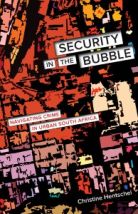Security in the Bubble: Navigating Crime in Urban South Africa

Security in the Bubble: Navigating Crime in Urban South Africa is part of the Globalization and Community series. It stems from Christine Hentschel’s doctoral dissertation, which examines the emergence of new spatialities of security governance in urban South Africa, based on the case of Durban.
Hentschel uses the paradigm of bubbles to interpret the landscape of security governance in this post-apartheid city. She views bubbles of governance as representing temporal spaces that can vary in size, purpose and modes of operation, and that are inherently spaces both longing for safety and giving the illusion of safety (page 2). To explore the landscape of bubbles in Durban, Hentschel looks at two security governance regimes: “handsome space” and “instant space”. Although she acknowledges that bubbles cannot be trusted to create security, she emphasizes the importance of appreciating how spatial security governance is played out through them, and how they contribute to theorizing security governance (page 3).
In her introduction Hentschel outlines the premise for her book and explains why she believes Durban is a relevant case study. She also describes her own research journey and sets forth the book’s contents.
Chapter 1 commences with Hentschel building a historical framework for the politics of crime and space in urban South Africa, and in particular Durban. It draws attention to spatial methods, such as compartmentalization, to govern cities. It also emphasizes how post-apartheid cities are still haunted by the spatial morphology left behind by apartheid urbanism (page 36). To close the chapter, Hentschel explains how softer, more inclusive forms of governance are also responsible for post-apartheid spatialities.
Chapter 2 develops conceptual and practical tools for analysing layers of security in Durban. It also outlines Hentschel’s research methodology.
In Chapter 3, Hentschel looks at “handsome space” – the first of two regimes she studies to analyse spatial security governance. Hentschel explores the logic behind and techniques employed by handsome space, and considers the “new widespread and unquestioned belief in the aesthetic and affective power of urban spaces” (page 57).
Turning to the second regime, Chapter 4 explores “instant space” and analyses how security is sought through crime avoidance techniques, which are supported by technology and instant information and communication. This type of governance is described as governing through fleeing and illustrates how striving for security becomes a way of life (or survival style) (page 106).
In conclusion, Hentschel considers how the experience of seeking security in Durban reverberates with urban formations elsewhere. She discusses how spatially “softer, affective, and communicative techniques of security” offer potential for governance (page 118). Furthermore, Hentschel identifies how these bubbles enable her to address the dimensions of “survivalzenship” (escape within the city) and “making love to the city” (urban utopianism) within her study of post-apartheid urban South Africa.
Book note prepared by Hannah Keren Lee
Search the Book notes database
Our Book notes database contains details and summaries of all the publications included in Book notes since 1993 - with details on how to obtain/download.
Use the search form above, or visit the Book notes landing page for more options and latest content.
For a searchable database for papers in Environment and Urbanization, go to http://eau.sagepub.com/

